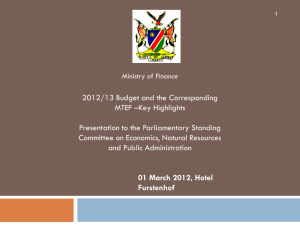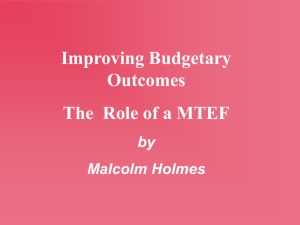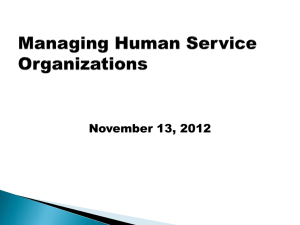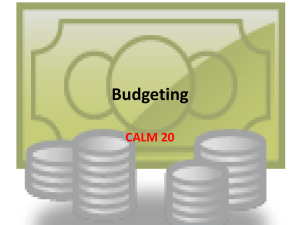Introduction to MTEF in Korea
advertisement
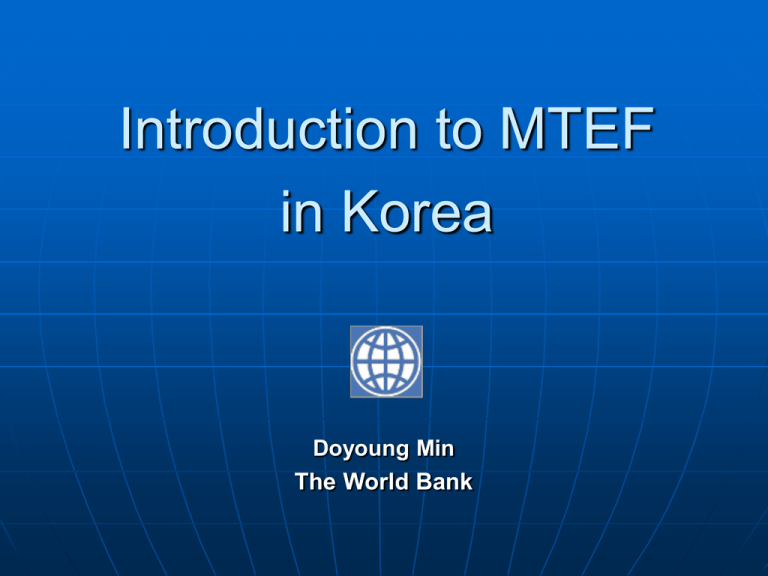
Introduction to MTEF in Korea Doyoung Min The World Bank Public Expenditure Public Expenditure Analysis (PEA) • “What” is to be done Public Expenditure Management (PEM) • “How” it is to be done 2 Public Expenditure Analysis The role of the state Public spending and budget deficit Efficiency Equity Fiscal decentralization 3 Public Expenditure Management MTEF • Linking policy, planning and budgeting Performance management Integrated Financial management information system (IFMIS) Fiscal transparency 4 Medium-Term Expenditure Framework Background of MTEF Changing role of budgeting • from control (spending) to management (policy) Increasing difficulty of maintaining fiscal soundness • slowed economic growth, built-in entitlement Growing demand for public spending • aging population, education, social welfare Demand for more democratized and transparent budgeting process 6 Objectives of MTEF Integrating national policy priorities into annual budget Providing medium-term perspective on expenditure plan Enhancing operating efficiency with increased LMs’ discretion over their spending Strengthening feedback and accountability mechanism by performance management 7 International Experiences (1) Coverage of MTEF Responsibility of economic assumption Multi-year cost estimate for new spending Sweden 3 yrs MOF All spending items UK 5 yrs CBO All spending items Australia 4 yrs CBO All spending items NZ 2 yrs MOF All spending items Netherlands 4 yrs CPB All spending items Norway varying MOF No USA N/A N/A All spending item MOF: different part of MOF/Treasury, CBO: central budget office, CPB: Central Planning Bureau Source: OECD-World Bank Budget Practices and Procedures Database 8 International Experiences (2) Basis of setting spending limit for ministries Final decision on ministries’ spending Arrangement in congress to establish total budget before individual item Sweden MTEF Prime Minister Yes UK MTEF MOF No Australia MTEF Cabinet No NZ MTEF Cabinet No Netherlands MTEF Cabinet Yes Norway N/A Cabinet Yes USA Suggestion only President Yes Source: OECD-World Bank Budget Practices and Procedures Database 9 Lessons from International Experiences Integration of multi-year planning with annual budget • MTEF and annual budgeting is ‘one’ process Honest/realistic macroeconomic forecasting Separation of total budget from detailed program Clarification of new roles of MOF/line ministries Capacity building and incentives for MOF/LMs Development of feedback mechanism 10 MTEF in Korea Budgeting in the Past Centralized and itemized budgeting • Input control High reliance on bottom-up approach MPB’s deep involvement in program budgeting Lack of macro perspectives Separated, individual fiscal initiatives 12 Past Fiscal Reform Efforts Strengthen linkage between formulation and execution Bring in incentive system for expenditure savings Pilot performance-based budgeting Introduce double-entry accounting system Improve aggregate expenditure control Introduce ex-ante evaluation system for major projects 13 Recent Fiscal Reform Initiatives 2003: Design and preparation of PEM reform • NFMP, Top-down, Performance management 2004: Implementation of a series of fiscal reform initiatives • National Fiscal Management Plan covers 5 years on a rolling basis includes General account, Special accounts, and Funds • Top-down budgeting MPB gives sectoral ceilings to LMs • Performance management Program budgeting • Digital budget and accounting system 2005: Strengthen the link among reform initiatives • FY06 budget prepared through new PEM system 14 Korea’s MTEF NFMP + Top-down Benchmarked Swedish model MPB’s initiatives / Champion • Track-record: Economic Planning Board (1961-1994) planning and budgeting functions reside under one roof Strong leadership (President) was backed up Lack of Parliament’s participation 15 New Budget Process (1) Stage I : Macroeconomic Forecasting and Long-term Fiscal Management Planning • Forecast macro variables for fiscal policy purpose • Consider social, political and international factors • Strengthen MPB’s role consult with MOFE, Bank of Korea and public/private research institutes strengthen MPB’s capacity of macroeconomic analysis and institutional coordination 16 New Budget Process (2) Stage II : Fiscal Targeting, Budget Envelope, and Sectoral Allocation • Fiscal targeting based on macro variables and policy objectives • Set out budget envelop with updated cost estimates • Sectoral allocation according to national policy priority, previous year’s performance information, and unexpected events * Sectoral categories vary by country Sweden(27), Canada(10), Norway(by Ministry) 17 New Budget Process (3) Stage III : Cabinet Meetings • Prepared by MPB in consultation with President Budget envelop Sectoral ceiling Major national policies • 2-day Cabinet meeting for consensus building (held on April 30 and May 1 for FY06 budget) 18 New Budget Process (4) Stage IV: Line Ministries’ Requests • Line ministries prepare budget request within provided sectoral ceiling In line with sectoral policy priority Increased discretion • MPB’ guidelines for formulating budget proposal Tools for consistent budget presentation, analysis, statistics Gradual phase-out of interventional aspects 19 New Budget Process (5) Stage V: Review and Documentation • MPB reviews LMs’ budget request checking the sectoral ceiling examine programs according to agreed sectoral priorities • MPB’s active interaction with line ministries • Sufficient involvement of the President in budgeting process 20 MTEF Process Macroeconomic forecasting Fiscal Target Updated cost estimate of existing policy/program Total Expenditure Setting For multi years New sectoral demand for t+2 (priority/cost) Sectoral Ceiling Setting for multi years Annual Budget Formulation Sectoral Budget Preparation 21 Changes Made Medium-perspective on expenditure framework • NFMP + annual budgeting Focus on Performance Management • Created Performance bureau Organizational Restructuring • Matrix: Function and Sector • Strengthened Strategic Planning role Address budgetary basics • Budget and Accounting Reinvention Office • Introduce Program budgeting • IFMIS 22 Challenges Remained (1) Integration of NFMP to annual budget • Annual budget should be the first year budget of NFMP Macro-forecasting capacity • MPB’s internal capacity building • Cooperation between MPB and MOFE Bank of Korea, research institutes • International cases: UK, Sweden, and France 23 Challenges Remained (2) Players’ willingness and commitment • Understanding of PE and MTEF MPB’s proper guideline for LMs • Identification of new roles Autonomy and Accountability: MPB and LMs Change of organizational culture in addition to organizational restructuring • Performance-oriented • Comprehensive government reform including civil service system 24
